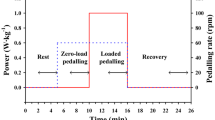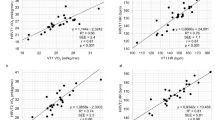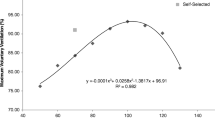Abstract
The present study investigated whether ‘break-points’ in breathing pattern correspond to the first (\( G_{{{\text{EX}}_{1} }} \)) and second gas-exchange thresholds (\( G_{{{\text{EX}}_{ 2} }} \)) during incremental cycling. We used polynomial spline smoothing to detect accelerations and decelerations in pulmonary gas-exchange data, which provided an objective means of ‘break-point’ detection without assumption of the number and shape of said ‘break-points’. Twenty-eight recreational cyclists completed the study, with five individuals excluded from analyses due to low signal-to-noise ratios and/or high risk of ‘pseudo-threshold’ detection. In the remaining participants (n = 23), two separate and distinct accelerations in respiratory frequency (f R) during incremental work were observed, both of which demonstrated trivial biases and reasonably small ±95% limits of agreement (LOA) for the \( G_{{{\text{EX}}_{1} }} \) (0.2 ± 3.0 ml O2 kg−1 min−1) and \( G_{{{\text{EX}}_{ 2} }} \) (0.0 ± 2.4 ml O2 kg−1 min−1), respectively. A plateau in tidal volume (V T) data near the \( G_{{{\text{EX}}_{1} }} \) was identified in only 14 individuals, and yielded the most unsatisfactory mean bias ±LOA of all comparisons made (−0.4 ± 5.3 ml O2 kg−1 min−1). Conversely, 18 individuals displayed V T-plateau in close proximity to the \( G_{{{\text{EX}}_{ 2} }} \) evidenced by a mean bias ± LOA of 0.1 ± 3.1 ml O2 kg−1 min−1. Our findings suggest that both accelerations in f R correspond to the gas-exchange thresholds, and a plateau (or decline) in V T at the \( G_{{{\text{EX}}_{ 2} }} \) is a common (but not universal) feature of the breathing pattern response to incremental cycling.


Similar content being viewed by others
References
Ahmaidi S, Hardy JM, Varray A, Collomp K, Mercier J, Prefaut C (1993) Respiratory gas exchange indices used to detect the blood lactate accumulation threshold during an incremental exercise test in young athletes. Eur J Appl Physiol 66:31–36
Aliverti A, Stevenson N, Dellaca RL, Lo Mauro A, Pedotti A, Calverley PM (2004) Regional chest wall volumes during exercise in chronic obstructive pulmonary disease. Thorax 59:210–216
Bartlett D Jr, Sant’ambrogio G (1976) Effects of local and systemic hypercapnia on the discharge of stretch receptors in the airways of the dog. Respir Physiol 26:91–99
Beaver WL, Wasserman K, Whipp BJ (1986) A new method for detecting anaerobic threshold by gas exchange. J Appl Physiol 60:2020–2027
Benito PJ, Calderon FJ, Garcia-Zapico A, Legido JC, Caballero JA (2006) Response of tidal volume to inspiratory time ratio during incremental exercise. Arch Bronconeumol 42:62–67
Bhambhani Y, Malik R, Mookerjee S (2007) Cerebral oxygenation declines at exercise intensities above the respiratory compensation threshold. Respir Physiol Neurobiol 156:196–202
Cannon DT, Kolkhorst FW, Buono MJ (2009) On the determination of ventilatory threshold and respiratory compensation point via respiratory frequency. Int J Sports Med 30:157–162
Carey D, Schwarz L, Pliego GJ, Raymond RL (2005) Respiratory rate is a valid and reliable marker for the anaerobic threshold: implications for measuring change in fitness. J Sports Sci Med 4:482–488
Carter H, Jones AM, Barstow TJ, Burnley M, Williams C, Doust JH (2000) Effect of endurance training on oxygen uptake kinetics during treadmill running. J Appl Physiol 89:1744–1752
Carter H, Pringle JS, Jones AM, Doust JH (2002) Oxygen uptake kinetics during treadmill running across exercise intensity domains. Eur J Appl Physiol 86:347–354
Chase P, Arena R, Guazzi M, Myers J, Peberdy MA, Bensimhon D (2010) Prognostic usefulness of the functional aerobic reserve in patients with heart failure. Am Heart J 160:922–927
Cheng B, Kuipers H, Snyder AC, Keizer HA, Jeukendrup A, Hesselink M (1992) A new approach for the determination of ventilatory and lactate thresholds. Int J Sports Med 13:518–522
Clark FJ, von Euler C (1972) On the regulation of depth and rate of breathing. J Physiol 222:267–295
Cross TJ, Morris NR, Haseler LJ, Schneider DA, Sabapathy S (2010a) The influence of breathing mechanics on the development of the slow component of O2 uptake. Respir Physiol Neurobiol 173:125–131
Cross TJ, Sabapathy S, Schneider DA, Haseler LJ (2010b) Breathing He-O2 attenuates the slow component of O2 uptake kinetics during exercise performed above the respiratory compensation threshold. Exp Physiol 95:172–183
Gaskill SE, Ruby BC, Walker AJ, Sanchez OA, Serfass RC, Leon AS (2001) Validity and reliability of combining three methods to determine ventilatory threshold. Med Sci Sports Exerc 33:1841–1848
Gitt AK, Wasserman K, Kilkowski C, Kleemann T, Kilkowski A, Bangert M, Schneider S, Schwarz A, Senges J (2002) Exercise anaerobic threshold and ventilatory efficiency identify heart failure patients for high risk of early death. Circulation 106:3079–3084
Hering E, Breuer J (1868) Die Selbststeurung der Athmung durch den Nervus vagus. Sitzungsber Akad Wiss Wien 57:672–677
Hug F, Laplaud D, Savin B, Grelot L (2003) Occurrence of electromyographic and ventilatory thresholds in professional road cyclists. Eur J Appl Physiol 90:643–646
James NW, Adams GM, Wilson AF (1989) Determination of anaerobic threshold by ventilatory frequency. Int J Sports Med 10:192–196
Jeong JW, Jang YW, Lee I, Shin S, Kim S (2009) Wearable respiratory rate monitoring using Piezo-resistive fabric sensor. In: Dössel O, Schlegel WC (eds) World congress on medical physics and biomedical engineering, September 7–12. Munich, Germany, Springer Berlin, pp 282–284
Johnson BD, Beck KC, Olson LJ, O’ Malley KA, Allison TG, Squires RW, Gau GT (2000) Ventilatory constraints during exercise in patients with chronic heart failure*. Chest 117:321–332
Jones AM, Doust JH (1998) Assessment of the lactate and ventilatory thresholds by breathing frequency in runners. J Sports Sci 16:667–675
Jones AM and Poole DC (2005) Oxygen uptake kinetics in sport, exercise and medicine. London; New York: Routledge, 2005, p xxv, 405
Legrand R, Prieur F, Marles A, Nourry C, Lazzari S, Blondel N, Mucci P (2007) Respiratory muscle oxygenation kinetics: relationships with breathing pattern during exercise. Int J Sports Med 28:91–99
Lucia A, Carvajal A, Calderon FJ, Alfonso A, Chicharro JL (1999) Breathing pattern in highly competitive cyclists during incremental exercise. Eur J Appl Physiol 79:512–521
Motulsky HJ, Brown RE (2006) Detecting outliers when fitting data with nonlinear regression—a new method based on robust nonlinear regression and the false discovery rate. BMC Bioinformatics 7:123
Mustafa ME, Purves MJ (1972) The effect of CO2 upon discharge from slowly adapting stretch receptors in the lungs of rabbits. Respir Physiol 16:197–212
Nabetani T, Ueda T, Teramoto K (2002) Measurement of ventilatory threshold by respiratory frequency. Percept Mot Skills 94:851–859
Neder JA, Stein R (2006) A simplified strategy for the estimation of the exercise ventilatory thresholds. Med Sci Sports Exerc 38:1007–1013
Ozcelik O, Ward SA, Whipp BJ (1999) Effect of altered body CO2 stores on pulmonary gas exchange dynamics during incremental exercise in humans. Exp Physiol 84:999–1011
Santos EL, Giannella-Neto A (2004) Comparison of computerized methods for detecting the ventilatory thresholds. Eur J Appl Physiol 93:315–324
Schelegle ES, Green JF (2001) An overview of the anatomy and physiology of slowly adapting pulmonary stretch receptors. Respir Physiol 125:17–31
Schoener EP, Frankel HM (1972) Effect of hyperthermia and PaCO2 on the slowly adapting pulmonary stretch receptor. Am J Physiol 222:68–72
Sherrill DL, Swanson GD (1984) Estimation of response slopes in respiratory control. J Appl Physiol 56:536–539
Sherrill DL, Anderson SJ, Swanson G (1990) Using smoothing splines for detecting ventilatory thresholds. Med Sci Sports Exerc 22:684–689
Solberg G, Robstad B, Skjønsberg O, Borchsenius F (2005) Respiratory gas exchange indices for estimating the anaerobic threshold. J Sports Sci Med 4:29–36
Steding K, Buhre T, Arheden H, Wohlfart B (2010) Respiratory indices by gas analysis and fat metabolism by indirect calorimetry in normal subjects and triathletes. Clin Physiol Funct Imaging 30:146–151
Takano N (2000) Respiratory compensation point during incremental exercise as related to hypoxic ventilatory chemosensitivity and lactate increase in man. Jpn J Physiol 50:449–455
Thompson SM, Coyle MA, Stager JM, Brown JB (2003) Comparison of ventilatory threshold measurements made by ambulatory plethysmography and by a mass flow device. Med Sci Sports Exerc 35:S117
Vieth E (1989) Fitting piecewise linear regression functions to biological responses. J Appl Physiol 67:390–396
von Duvillard SP, LeMura LM, Bacharach DW, Di Vico P (1993) Determination of lactate threshold by respiratory gas exchange measures and blood lactate levels during incremental load work. J Manipulative Physiol Ther 16:312–318
Wasserman K, Hansen J, Sue D, Stringer W, and Whipp B. Principles of exercise testing and interpretation : including pathophysiology and clinical applications. Philadelphia: Lippincott Williams and Wilkins, 2005, p xvi, 585
Whipp BJ (2007) Physiological mechanisms dissociating pulmonary CO2 and O2 exchange dynamics during exercise in humans. Exp Physiol 92:347–355
White MD, Cabanac M (1996) Exercise hyperpnea and hyperthermia in humans. J Appl Physiol 81:1249–1254
Wisen AG, Wohlfart B (2004a) Aerobic and functional capacity in a group of healthy women: reference values and repeatability. Clin Physiol Funct Imaging 24:341–351
Wisen AG, Wohlfart B (2004b) A refined technique for determining the respiratory gas exchange responses to anaerobic metabolism during progressive exercise—repeatability in a group of healthy men. Clin Physiol Funct Imaging 24:1–9
Yoshida T, Suda Y, Takeuchi N (1982) Endurance training regimen based upon arterial blood lactate: effects on anaerobic threshold. Eur J Appl Physiol 49:223–230
Zoladz JA, Korzeniewski B (2001) Physiological background of the change point in VO2 and the slow component of oxygen uptake kinetics. J Physiol Pharmacol 52:167–184
Zoladz JA, Rademaker AC, Rademaker AC, Sargeant AJ et al (1995) Non-linear relationship between O2 uptake and power output at high intensities of exercise in humans. J Physiol 488(Pt 1):211–217
Acknowledgments
The authors of the present study would like to thank Sarah Joyce, Melissa Waters and Jennifer Isautier for their assistance in data collection. This research project was supported in part by a Griffith University New Researcher Grant (S.S.) and the School of Physiotherapy and Exercise Science.
Conflict of interest
The authors of the present study have no conflict of interest to declare.
Author information
Authors and Affiliations
Corresponding author
Additional information
Communicated by Susan A. Ward.
Rights and permissions
About this article
Cite this article
Cross, T.J., Morris, N.R., Schneider, D.A. et al. Evidence of break-points in breathing pattern at the gas-exchange thresholds during incremental cycling in young, healthy subjects. Eur J Appl Physiol 112, 1067–1076 (2012). https://doi.org/10.1007/s00421-011-2055-4
Received:
Accepted:
Published:
Issue Date:
DOI: https://doi.org/10.1007/s00421-011-2055-4




